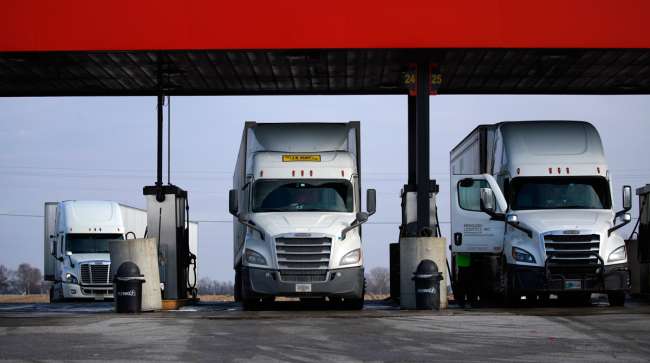Staff Reporter
EIA Cuts Diesel Price Forecast Despite Harvest Season Uptick

[Stay on top of transportation news: Get TTNews in your inbox.]
Retail and wholesale diesel prices are expected to remain softer than 12 months ago, while residential heating oil prices are set to fall 5% year over year this winter, according to the latest Energy Information Administration data.
Forecasts for trucking’s main fuel, which alongside heating oil is part of the distillate portion of the crude barrel, softened over the past month even as retail prices edged slightly higher ahead of the peak Midwest harvest season.
The national average diesel price increased 4 cents week over week to $3.584 per gallon through Oct. 7, EIA data shows, marking a third straight rise. However, the cumulative increase only totaled 5.8 cents and followed 10 consecutive decreases. For context, the national average is down 91.4 cents year over year.
Little change is expected in the coming months. Retail diesel prices are expected to average $3.54 per gallon in the fourth quarter of 2024 and $3.53 per gallon in the first three months of 2025, down 1.8% and 4%, respectively, compared with EIA forecasts in September, the agency said Oct. 8 in its most recent Short-Term Energy Outlook.
EIA expects the retail diesel price will average about $3.50 per gallon in 2025, down 5% from its forecast a month earlier.
The agency cut its Q4 wholesale diesel price forecast by 11.2% to $2.06 a gallon from $2.32. The agency’s forecast for average 2024 wholesale diesel prices is now $2.40, compared with $2.50 a month ago. In 2025, EIA expects wholesale diesel prices to average $2.30 per gallon, an 8.4% decrease compared with a month previous.
McLeod Software CEO Tom McLeod explores the potential for artificial intelligence to boost efficiency and build resilience. Tune in above or by going to RoadSigns.ttnews.com.
Despite rising geopolitical tensions, the agency cut its spot Brent crude price forecast to $78 per barrel in 2025, $7 a barrel below the prior month’s expectations, largely due to an expected decrease in global oil demand growth. Investment bank Citi is projecting a slide in front-month Brent futures to $65 a barrel in Q1 and then $60 a barrel as the year ends.
Diesel demand globally is also waning, particularly in China, sapping strength from benchmark markets.
In August, EIA noted diesel consumption in China totaled 3.9 million barrels per day in June, a decline of 11% from the same month last year and the largest year-over-year decline in consumption for any month since July 2021.
EIA attributed the decline in diesel consumption to a slowdown in economic activity, largely due to slowing building and housing construction, and liquefied natural gas replacing diesel as the fuel for heavy-duty trucks.
Front-month Brent crude futures topped $80 a barrel for the first time since August on Oct. 7. Over the past month, crude prices and therefore refined product markets increased due to geopolitical turmoil, although the relative weakness before the climb is important to note.
Want more news? Listen to today's daily briefing above or go here for more info
On Sept. 6, as Oil Price Information Service founder and energy analyst Tom Kloza noted on X, front-month benchmark WTI futures had not closed lower in 452 days, gasoline futures in 1,229 days and wholesale diesel futures in 1,008 days.
Retail Midwest diesel prices climbed 6.7 cents to average $3.587 per gallon in the most recent week, largely due to harvest demand, but were 78.9 cents lower year over year.
The harvest typically peaks in mid-October and continues through November, according to EIA. The 2024 harvest is expected to be on schedule or slightly ahead of schedule.
Midwest crops of corn and soybeans are progressing slightly ahead of schedule, according to the U.S. Department of Agriculture, and the ratio of soybean acreage to corn acreage is above prior years, with the former having a slightly earlier harvest season than the latter.
The end of the harvest season is typically followed by a ramp-up in demand for heating oil, maintaining some demand for distillates.
EIA expects an average price of about $4.20 a gallon for residential heating oil this winter, around 10 cents per gallon less than in the previous winter.
One reason, and it is a positive factor for fleet fuel purchasers in the coming months, is a smaller crack spread for distillates.
EIA expects the heating oil crack spread this winter — the difference between the wholesale price of heating oil and crude oil — to be about 80 cents per gallon this winter, around 25 cents per gallon lower than last winter.
Context is important in analyzing that decrease. Heating oil prices and crack spreads a year ago were at historic highs.
EIA said many factors that led to the high distillate crack spread a year ago remain in place, including lower regional, national and global distillate inventories; and lower regional refinery capacity compared with pre-pandemic levels.
However, demand for U.S. distillate fuel is down, U.S. and global refinery capacity is higher, and the global distillate supply chain has returned to normal after the chaos that followed Russia’s invasion of Ukraine in 2022.





